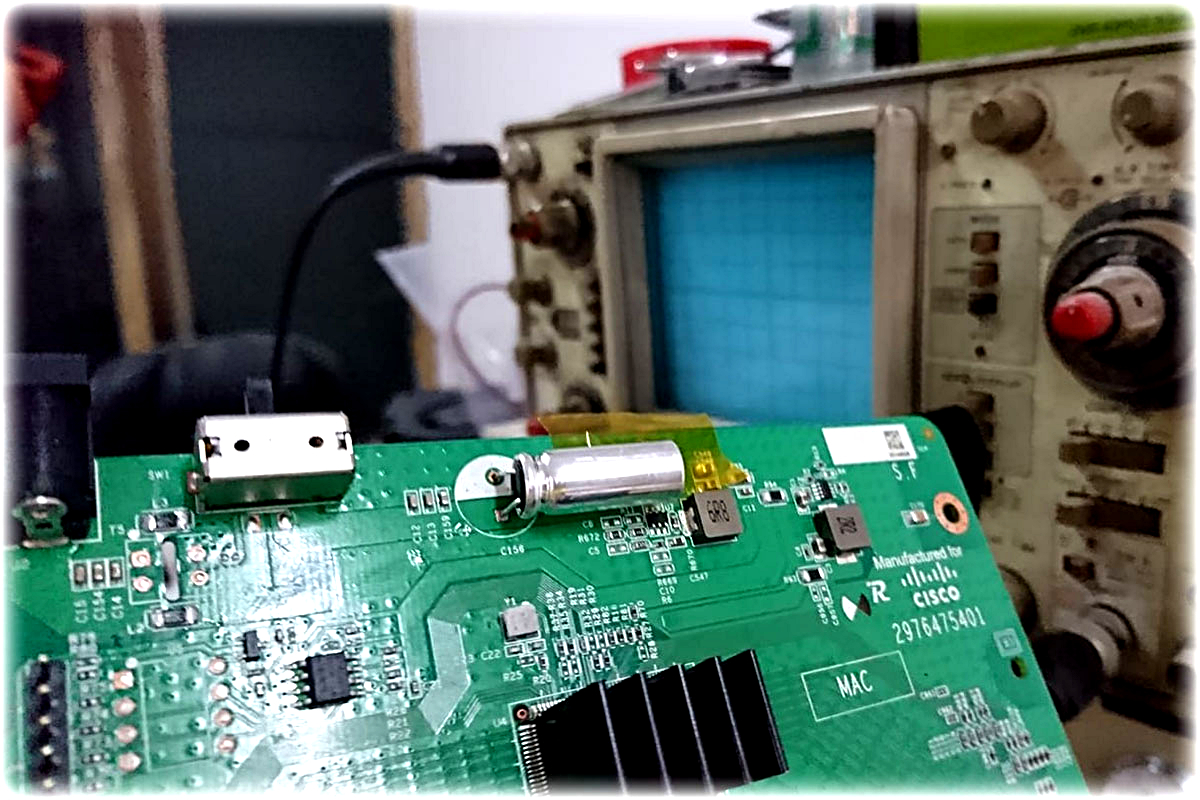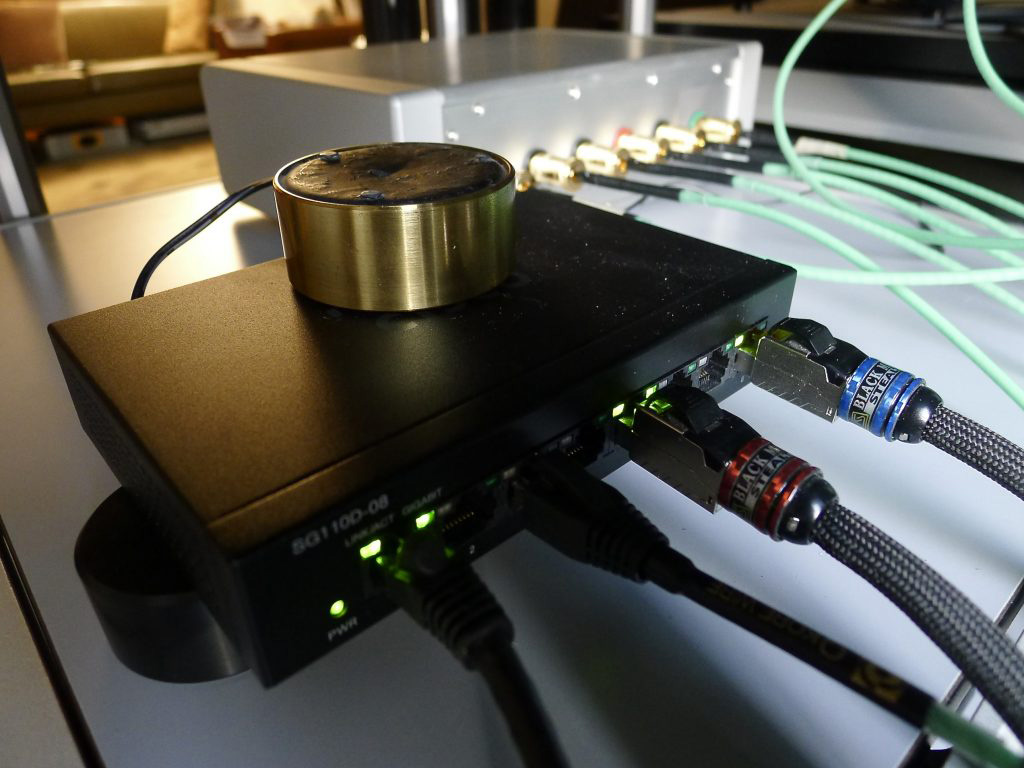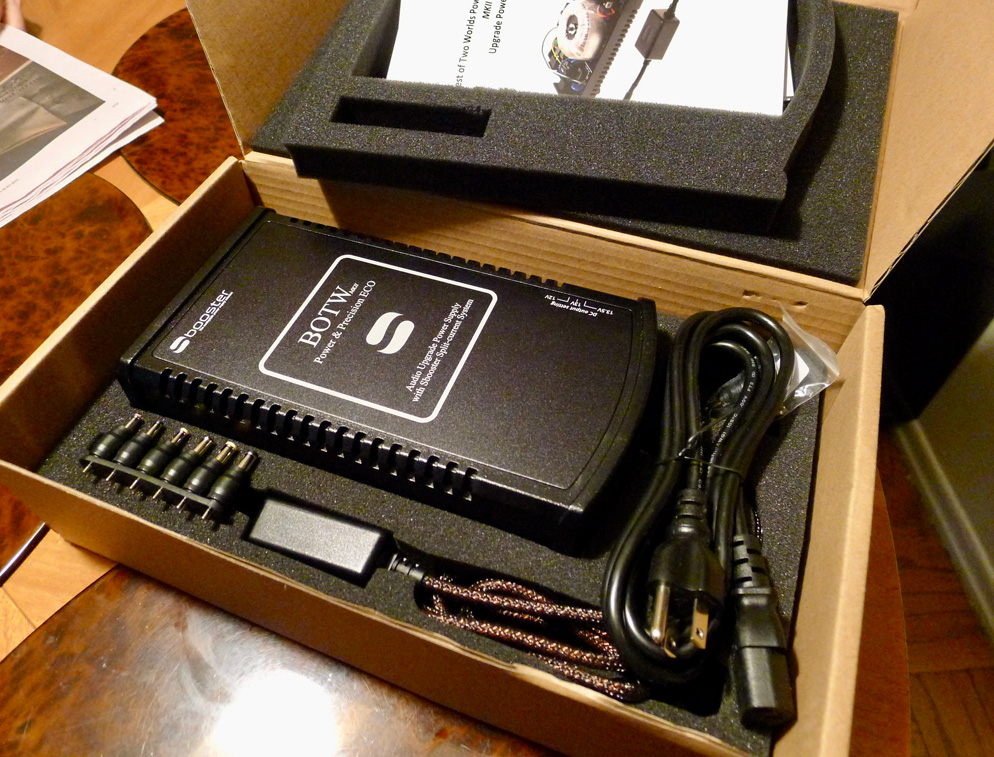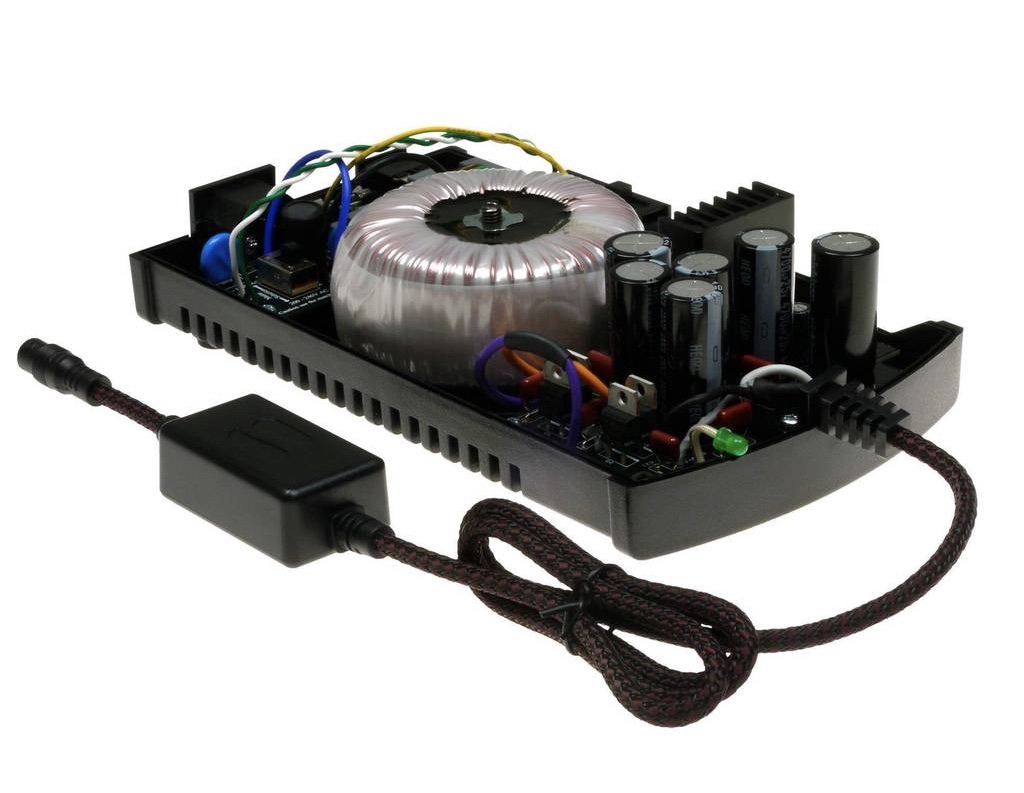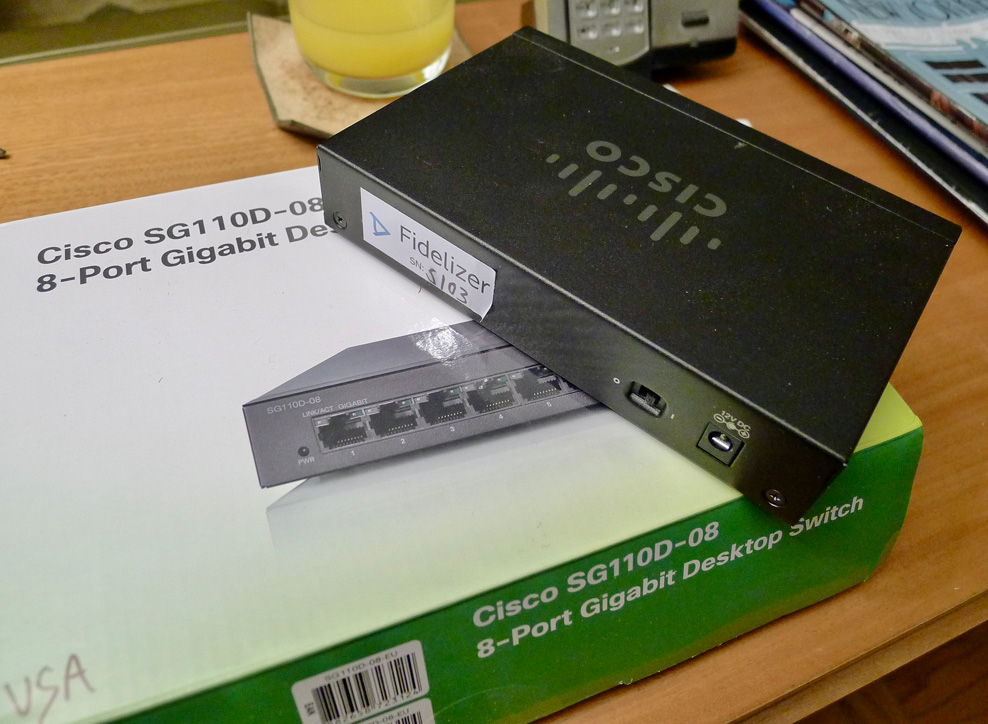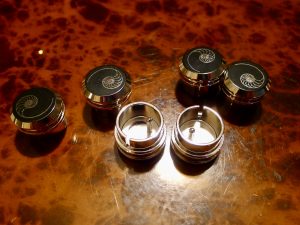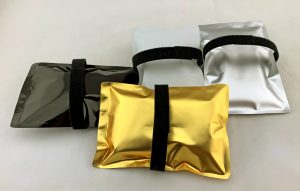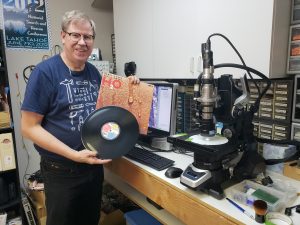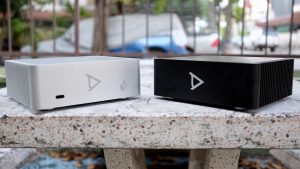I had not yet drunk the Kool-Aid—I was more of a doubting Thomas—when the package arrived. My West Coast editor advised me, "Just swap out the one you have, plug this one in, give it the requisite 50 hours, and then take a sip," or something to that effect.
In the box was a new product from Fidelizer, an audiophile boutique based in Thailand. Their EtherStream Network Switch was slated to replace the off-the-shelf TP-Link switch I purchased from Home Depot for $35 for my Ethernet front-end. Would the EtherStream make a difference and, if so, would it be worth $399? I had my doubts, but was willing to give it a shot.
First, a quick overview of where I stand with music servers. I had recently gotten into the game by putting together USB and Ethernet server front-ends, but I can't say I'm a fan of either. In my system, Ethernet delivery is significantly better than USB, perhaps because the latest Ethernet upgrade was installed on my CH Precision C1 DAC. (CH Precision has been moving ahead with a focus on Ethernet.) But still, it was not even close to the CD via the CH D1 transport. My main complaint with Ethernet was a pronounced softness—where was that coming from?
A friend had recently extolled the Saint-Saëns - Piano Concertos Nos 1, 2, and 4, with Louis Lortie on piano and Edward Gardner conducting the BBC Philharmonic (Chandos CHAN 20031, FLAC 96KHz 24bit). I cued it up on Qobuz using the Roon app on my Ethernet front-end. The Fidelizer EtherStream was in-line, its wall-wart plugged into an Ensemble power strip on an AC circuit separate from my main dedicated lines. (There is a reason I kept it on a different AC line we'll get to shortly.)
The Softness is Nailed: It's the TP-Link Network Switch!
After hitting PLAY, it only took seconds before my eyes opened wide. The piano was crisp and sparkling, with good edge definition and texture. WOW! Just like that, the culprit was nailed—and this was only my first sip! For confirmation, I swapped back to the TP-Link switch and, sure enough, the excessively soft presentation was there again. The TP-Link did not produce what we call a soundstage. It only had width and height, no depth, it was 2-D flat like a paint gun splatter. The images were swimming together as notes emanated from an ill-defined place, indistinct, hollow sounding, and lacking a tonal center. This is what happens when the music doesn't have a good foundation. Without support, the soundstage gets spongy.
A firm foundation underpinning the stage is very important. When you build a house, the foundation is laid first and everything that sits on it, depends on it. If it's unstable, the whole structure becomes insecure and wobbly. Same with instruments on a soundstage. The EtherStream firmed up the structure and presented a 3-D stage layered side to side and front to back, populated with decently sized images.
Well, this was quite a flip from the last time I streamed with Ethernet. My brain struggled to process what just happened. Unawares, I had slipped into the mindset of the audio objectivists, the deniers of differences. I put together these streaming front-ends on the cheap without giving them much thought, thinking parts is parts. It never crossed my mind to give the switch a second thought. Damn! It's the same old lesson I have to relearn (let alone the undesirable association with the deniers). Remember: rule number one in the High-End is everything counts. When you've been doing this long enough, time and again, it's the things from out in left field, the stuff you think can't possibly matter, that blindside you.
The foundation of the soundstage was not the only thing that changed. After burn-in (yes, a new EtherStream needs about 200 hours for optimal performance), the music had a decidedly acoustic bent with nice flow and satisfactory timbre. Tonal balance was evenly disbursed from the decent low-end up to a natural treble, plus there was some flesh on the bones. The EtherStream is positioned to appeal to the audiophile market, but it didn't produce the stereotype of bleached, hyper-detailed, fast, and edgy audiophile sound.
One other thing: according to the Fidelizer website, a primary design goal for the EtherStream product was to address many consumers' poor opinion of streaming vs. music files on local storage. Based on my own explicit comparison, the EtherStream gives you the same playback quality from Qobuz as music files on local storage. There was no audible difference.
The Audiophile Treatment
Clearly, a shift in mindset was needed. This front-end deserved the same serious consideration as any of my other sources. With that in mind, I made a punch list for the EtherStream. The first order of business was to move it from the floor to my TAOC rack. The EtherStream is very compact and flyweight (4"D x 1.31"H x 6.25"W and 0.94 lbs). The pull exerted by the lightweight Ethernet cables attached to it was enough to make it list backward. I placed a Walker Audio Resonance Control Disc weight on top to stabilize the box, give it some mass, and damp vibration. While at it, I put a pair of edenSound TerraStone Pure Cylinder isolation pucks underneath. Did I mention it was already connected to the Nordost QKORE Ground system? Yes, yes, and yes, each step added bounty: images fleshed out, tone gained weight, dynamics improved, nothing was loose on this stage. (Perhaps the footers went too far as I soon removed them, but you should give it a try and see.)
The Wall-Wart Issue
The next step on the punch list was to plug it into a Nordost QBASE Power Distributor on one of my dedicated lines. Now a new problem surfaced. It's no secret that switch-mode power supplies are notoriously noisy—the wall-wart was degrading my other sources. I quickly moved it back to the Ensemble power strip on a secondary AC line.
But even here, being newly attuned to the wall-wart's effects, I could still hear it, if a bit less than when it was on the QBASE. (I bet if I went around the room and pulled out all the other wall-warts, like the one for my humidifier, sonic benefits would accrue. But what's an apartment dweller to do—you've got to live.) The short term solution was to disconnect the wall-wart from the wall when not listening to Ethernet.
Here we go again. Why do products for the audiophile market come with a wall-wart? Of course I know why—the expense. Obviously, it should be replaced. There are better wall-warts (a friend mentioned the iFi iPower for $50), but why be timid? The best solution is a linear power supply. Fidelizer has one (the Nikola Signature, MSRP $695), but the designer didn't want to send it, because he felt its price was not in line for supporting a product with a $399 MSRP. He has a scaled down LPS in the works for the EtherStream (the Nikola Classic, MSRP $395), but ETA is unknown. In the meantime, he said I could go ahead with a third party LPS.
The Sbooster BOTW P&P ECO MKII Power Supply
My editor had encouraging words about the Sbooster for offering the best price / performance ratio, so I requested a BOTW P&P ECO MKII Power Supply from Upscale Audio (MSRP $359). The tongue twisting acronym stands for "Best Of Two Worlds Power & Precision."
The Sbooster is a well-made, compact chassis of bigger proportions and weight than the EtherStream. It contains a lot of circuitry plus a big transformer and I was advised to let it cook for 100 hours. Meanwhile, I did my first test to gauge what effect it had on my other sources.
Yes, it could be heard in the same way as when any beefy power supply is added to the system, such as an external power supply for a preamp: a smoothing of the treble, a slight increase in soundstage focus and dimension, but mostly greater tonal density. The one downside was some loss of immediacy. We judged these effects desirable overall, unlike those the wall-wart introduced. Remember, this is when I'm listening to sources other than Ethernet with the Sbooster powered on.
As for the Sbooster's contribution to Ethernet music… WOW!… This is no joke. The Sbooster made almost as much difference as the EtherStream switch itself. There is so much more heft it isn't even funny. It introduced a massive amount of flesh and body, and the entire frequency spectrum benefited, especially the low-end.
The piano sounded enriched because the keyboard was now attached to a wooden case, and that large physical object was resonating, imbuing the fundamental tones with distinct resonance and decay properties. So it was for each instrument.
In short, Ethernet playback with the Sbooster powering the EtherStream made the sound of the wall-wart seem as if it was submerged under water. The music's pulse slowed down… like it was slowly dying. (Further thoughts about the Sbooster will be coming along soon in a separate review.)
Cosmetics and Construction
Fidelizer takes a very good Cisco SG110D-08 switch with a list price of $100 and puts it through a makeover aimed for the audiophile market. (Check the website to get the list of upgraded parts.) The EtherStream does not disguise its origins; all the Cisco insignia remain in place, only a couple of adhesive labels indicate the product underwent a Fidelizer makeover. The EtherStream cosmetics are unabashedly of the home-brew variety.
Conclusion
The audiophile pursuit lends itself to a basic methodology. We look at the parts, use deductive reasoning to determine the important ones, and put our efforts into them. (The logic—and the endless tinkering—explains the appeal to nerdy types.) But that only takes you so far in pursuit of better sound. Sooner or later you will hit a scenario that confounds you and Rule Number One asserts itself: In the High-End everything counts, even the stuff deductive logic says shouldn't, even those we can't explain. I run into things that are not supposed to happen all the time.
It never crossed my mind to consider the network switch. And then, quite serendipitously, the Fidelizer EtherStream Network Switch came along and its impact was profound. It was more significant than the Ethernet cable upgrades I had done recently, and it costs less too. (Of course, one is no substitute for the other; their effects compound.) I was flat out amazed when the EtherStream eliminated my principle issue with Ethernet, the pronounced softness of the presentation, which was enough to make the difference between unacceptable and good. Rather a satisfying improvement for $395.
Happy with these results, I approached the EtherStream more seriously and soon stumbled upon the world of linear power supplies, a whole product subset on its own. The Sbooster BOTW P&P ECO MKII Power Supply, recommended to me as the best price / performance value, doubled down on the improvements. It should definitely be considered for audition.
In closing, I have to mention this is my first audiophile-quality network switch, and I only compared it to a consumer-grade TP-Link switch. There are others available from brands like SOtM and AQVOX that should be considered. The same can be said for the Sbooster, where there is at least as much competition in the LPS sector.
EtherStream Network Switch
Retail: $395
Fidelizer




